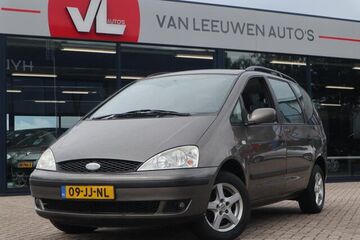
Ford Galaxy 2.3 Trend
Before the start of the joint project of limousine-vans, Ford and Volkswagen opened a factory in Portugal, to which they contributed an equal share of the funds. Of course, both Galaxy and Sharani then rolled off the assembly lines. Well, about a year ago, Ford sold their stake to Volkswagen, and at the same time they made a deal that they would still manufacture the Galaxy in the factory anyway.
It is this layout that is even more prominent in the interior of the Galaxy, making it very recognizable, while the exterior with the headlights and grille strongly resembles the Focus, the sideline has remained largely unchanged, so it is now more of a Ford rear end.
Inside, the usually pretty Ford four-spoke steering wheel, which is adjustable for height and depth, is nicely styled, but at night, a slightly opaque oval clock at the top of the dashboard, scale graphics that say Galaxy on the tachometer, gear lever and radio. Everything else comes directly from Volkswagen, or at least strongly resembles it. Not that Ford was offended. After all, the twins come from the same production line, and economically justified miracles are simply impossible to afford. Be that as it may, you have to close one eye.
Inside there is room for a driver and six passengers or a huge amount of luggage. If you plan to carry passengers, everyone will be seated in their seats: two in the front row, three in the middle, and two in the back. For the third row, there is still enough room for 330 liters of luggage, which is probably not enough for the needs of all seven passengers. Well, if you remove the last row, which is not difficult at all, you get one and a half cubic meters of luggage compartment. Not enough yet?
Then remove the middle row and there will be room for 2.600 liters of luggage. And this. When driving with all seats installed but no passengers, we recommend folding the backrests of all seats one at a time, as this will give you a much better view of what is happening behind the vehicle.
The connection with Volkswagen also has the advantage of very good ergonomics in the cabin, which is much better than its predecessor. Members of the NBA basketball league will also have ample headroom, as well as richly measured inches in width. In addition, the longitudinal centimeters for the knees in the second and third rows can be additionally metered by the longitudinal seat adjustment (each seat is displaced approximately five centimeters). All types of seats are firm enough to leave your car relaxed, even after a long drive. In addition, the driver and front passenger can additionally relax their hands on the precisely adjustable armrests.
Another condition for a calm and tireless ride is also a good running gear. And Galaxy is among the best. When driving on an empty vehicle, the transmission of short bumps is at a fairly acceptable level, and when loaded it improves even more. At this time, the car also leans a little, but the transmission of bumps becomes more favorable and soft. However, in both cases the absorption of long waves is excellent and quite inconvenient.
While driving, it is also important how often you have to play with the shift lever so that the engine is not put under any load. The main choice is to connect the 2-liter four-cylinder engine to the five-speed manual transmission we tested. The engine is distinguished by its technical features - two compensating shafts to eliminate free moments of inertia in the engine and four-valve technology. All this still does not produce the most beautiful torque curve on paper, but in practice it turns out that the chosen motorization is just right for entering the world of the Galaxy. The device is a little more thirsty (average consumption on the test was 3 l / 13 km) than many would like, but a ton and 8 kg of sheet metal and plastic need to be transported with something.
On the other hand, the engine is quite maneuverable, which is most pronounced with less load on the car, because then you can afford to be lazy with the gear lever without the slightest twinge of conscience. It impresses to some extent with certain precise movements, but the enthusiasm is slightly dissipated by the sportier desire for quick gear changes. Then, when changing from second to third gear, the lever can get stuck in the guide of the first gear.
Of course, the brakes are also important. With good braking power, satisfactory measured values and ABS support, they do their job to a decent level and give the driver a sense of reliability.
The tested model was equipped with the Trend hardware package, in which almost everyone today is very desirable, if not completely necessary, accessories. These certainly include automatic air conditioning (separate for the front and rear), seven seats, front and side airbags in the front, ABS, a ten-speaker radio, and more. And if you end up adding a powerful enough powertrain, advanced and proven technology, roominess with superior flexibility, and a wealth of equipment, you will find that the purchase is well worth your money. Only Ford fans will be a little disappointed as they drive a Volkswagen with a bad Ford disguise.
Peter Humar
Photo: Urosh Potocnik.
Ford Galaxy 2.3 Trend
Basic data
| Sales: | Summit motors ljubljana |
|---|---|
| Base model price: | 22.917,20 € |
| Calculate the cost of auto insurance | |
| Power: | 107kW (145 KM) |
| Acceleration (0-100 km / h): | 12,3 with |
| Maximum speed: | 196 km / h |
| Mixed flow ECE: | 10,1l / 100km |
Technical information
| engine: | 4-cylinder - 4-stroke - in-line - petrol - transverse front mounted - bore and stroke 89,6 × 91,0 mm - displacement 2259 cm3 - compression 10,0:1 - maximum power 107 kW (145 hp) .) at 5500 rpm - maximum torque 203 Nm at 2500 rpm - crankshaft in 5 bearings - 2 camshafts in the head (chain) - 4 valves per cylinder - electronic multipoint injection and electronic ignition (EEC-V) - liquid cooling 11,4 l - engine oil 4,0 l - variable catalyst |
|---|---|
| Energy transfer: | front wheel motor drives - 5-speed synchronized transmission - gear ratio I. 3,667; II. 2,048 hours; III. 1,345 hours; IV. 0,973; V. 0,805; reverse 3,727 - differential 4,231 - tires 195/60 R 15 T (Fulda Kristall Gravito M + S) |
| Capacity: | top speed 196 km / h - acceleration 0-100 km / h 12,3 s - fuel consumption (ECE) 14,0 / 7,8 / 10,1 l / 100 km (unleaded gasoline, elementary school 95) |
| Transportation and suspension: | 5 doors, 7 seats - self-supporting body - front individual suspensions, leaf springs, triangular cross rails, stabilizer - rear individual suspensions, inclined rails, coil springs, telescopic shock absorbers, stabilizer - two-wheel brakes, front disc (forced cooling), rear power steering disc, ABS, EBV – power steering, power steering |
| Mass: | empty vehicle 1650 kg - permissible total weight 1958 - permissible trailer weight with brake 1800 kg, without brake 700 kg - permissible roof load 75 kg |
| External dimensions: | length 4641 mm - width 1810 mm - height 1732 mm - wheelbase 2835 mm - track front 1532 mm - rear 1528 mm - driving radius 11,1 m |
| Inner dimensions: | length 2500-2600 mm - width 1530/1580/1160 mm - height 980-1020 / 940-980 / 870 mm - longitudinal 880-1070 / 960-640 / 530-730 mm - fuel tank 70 l |
| Box: | (normal) 330-2600 l |
Our measurements
| T = 0 ° C, p = 1030 mbar, rel. vl. = 60% | |
| Acceleration 0-100km: | 12,0s |
|---|---|
| 1000m from the city: | 33,8 years ( 151 km / h) |
| Maximum speed: | 191km / h (V.) |
| Minimum consumption: | 12,4l / 100km |
| test consumption: | 13,8 l / 100km |
| Braking distance at 100 km / h: | 48,5m |
| Noise at 50 km / h in 3rd gear | 56dB |
| Noise at 50 km / h in 4rd gear | 55dB |
| Noise at 50 km / h in 5rd gear | 55dB |
| Test errors: | unmistakable |
evaluation
A car for people with a "galactic" high need for interior space, accommodating up to six (without a driver) passengers or 2,6 cubic meters of luggage.
We praise and reproach
open space
flexibility
engine
rich equipment
lack of identity
slightly higher consumption
intermittently blocking the gearbox during fast gear changes

